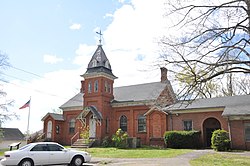
Tariffville is a neighborhood and census-designated place (CDP) in the town of Simsbury in Hartford County, Connecticut, United States. The population was 1,324 at the 2010 census. It is a popular location for whitewater paddlers who use the Farmington River.

Rockville is a census-designated place and a village of the town of Vernon in Tolland County, Connecticut, United States. The population was 7,920 at the 2020 census. Incorporated as a city in 1889, it has been consolidated with the town of Vernon since 1965.

The Farmington River is a river, 46.7 miles (75.2 km) in length along its main stem, located in northwest Connecticut with major tributaries extending into southwest Massachusetts. The longest route of the river, from the origin of its West Branch, is 80.4 miles (129.4 km) long, making it the Connecticut River's longest tributary by 2.3 miles (3.7 km) over the major river directly to its north, the Westfield River. The Farmington River's watershed covers 609 square miles (1,580 km2). Historically, the river played an important role in small-scale manufacturing in towns along its course, but it is now mainly used for recreation and drinking water.

Neshanic Station is an unincorporated community and census-designated place (CDP) located within Branchburg and extending into Hillsborough Township, Somerset County, in the U.S. state of New Jersey. In 2016 most of the village was listed on the National Register of Historic Places as the Neshanic Station Historic District.

Quinebaug Mill–Quebec Square Historic District is a historic district roughly bounded by the Quinebaug River, Quebec Square, and Elm and S. Main Streets in the town of Brooklyn in Windham County, Connecticut. The district encompasses a well-preserved 19th-century mill village. It was added to the National Register of Historic Places in 1985.

The Mill–Prospect Street Historic District in Hatfield, Massachusetts encompasses a historic landscape with over 300 years of industrial and agricultural history. It was listed on the National Register of Historic Places in 2002. The district runs along Prospect Street, a north-south road that roughly bisects Hatfield, from its southern end at Elm Street to a point north of its junction with Chestnut Street, and includes properties on adjacent roadways. The central focus of the district is the Mill River, which meanders from west to east across the district's middle. At the Prospect Street crossing is a cluster of former late 19th century industrial buildings, some of which comprise the Old Mill Site Historic District, listed in 1982.

The Glen Falls Bridge is a historic bridge that formerly carried Brunswick Avenue over the Moosup River in Plainfield, Connecticut. Built in 1886 by the Berlin Iron Bridge Company, it is one of a shrinking number of surviving 19th-century lenticular truss bridges in the state. The bridge was listed on the National Register of Historic Places in 1999. It has been closed to all traffic for many years.

Hallville Mill Historic District is a historic district in the town of Preston, Connecticut, that was listed on the National Register of Historic Places in 1996. Contributing properties in the district are 23 buildings, two other contributing structures, and one other contributing site over a 50-acre (20 ha) area. The district includes the dam that forms Hallville Pond, historic manufacturing buildings and worker housing, and the Hallville Mill Bridge, a lenticular pony truss bridge built circa 1890 by the Berlin Iron Bridge Company.
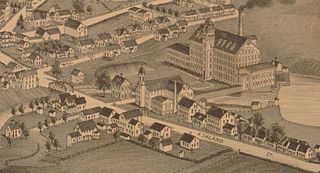
The Ashland Mill Bridge was a lenticular pony truss bridge over the Pachaug River in Griswold, Connecticut that was built in 1886 by the Berlin Iron Bridge Company. It was built following the Ashland dam break of February 1886 which washed away the previous bridges. The bridge served the millyard of the Ashland Cotton Company, in the Jewett City section of Griswold. The bridge was 65 feet (20 m) long and crossed a millrace on a skew angle. The Ashland Mill was damaged by arson in March 1995 and subsequently torn down, but the bridge itself remained. By 1999, the town deemed the bridge unsafe and closed it, and by February 1999, the bridge was moved to a vacant parking lot and was replaced with a new bridge. The bridge was added to the state of Connecticut historic register and it was later added to the National Register of Historic Places in April 1999. It was removed from the National Register in February 2016.
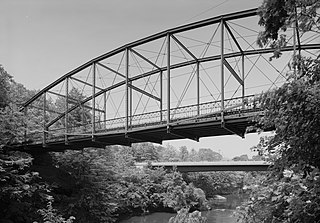
The Berlin Iron Bridge Company was a Berlin, Connecticut company that built iron bridges and buildings that were supported by iron. It is credited as the architect of numerous bridges and buildings now listed on the U.S. National Register of Historic Places. It eventually became part of the American Bridge Company.

The Bennington Village Historic District of Bennington, New Hampshire encompasses the 19th-century center of the village. Growth of the village followed a typical pattern for rural New Hampshire towns, based in this case around the growth in the early 19th century of the paper industry, which continues to be a significant economic force in the community. The district is centered on the junctions of Main, Center, and School Streets with Bible Hill Road and Francestown Road. The district was listed on the National Register of Historic Places in 2010.

The Quechee Historic Mill District encompasses the historic heart of the village of Quechee, Vermont, a well-preserved 19th-century mill village. Extending along Quechee Main Street between the Old Quechee Road and the Quechee-West Hartford Road, the village was settled in the 1760s, and has an industrial history extending into the 20th century. It was listed on the National Register of Historic Places in 1997.
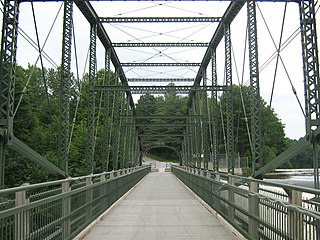
The Douglas & Jarvis Patent Parabolic Truss Iron Bridge is a historic bridge across the Missisquoi River in Highgate, Vermont. Located at the end of Mill Hill Road, it is at 215 feet (66 m) one of the longest bridges of its type in the northeastern United States. It was built in 1887, and was listed on the National Register of Historic Places in 1974.

The Warren Village Historic District encompasses the village center of Warren, Vermont, United States. Stretched mainly along Main Street east of the Mad River, it is a well-preserved 19th-century mill village, although most of its period mill infrastructure has been lost. The district has good examples of Greek Revival, Italianate, and Second Empire architecture. It was listed on the National Register of Historic Places in 1992.

The Minortown Road Bridge is a historic lenticular pony truss bridge in northeastern Woodbury, Connecticut. It spans the Nonewaug River, connecting U.S. Route 6 (US 6) to Minortown Road and Mill Road. Built in 1890 by the Berlin Iron Bridge Company, it is one a small number of surviving lenticular truss bridges in the state. It was listed on the National Register of Historic Places in 2001.

The Melrose Road Bridge is a historic bridge at the western end of Melrose Road in East Windsor, Connecticut. Built in 1888, it is one of a small number of surviving 19th-century lenticular pony truss bridge in the state. It was listed on the National Register of Historic Places in 1999. It has been closed for many years, and lacks stringers and decking.
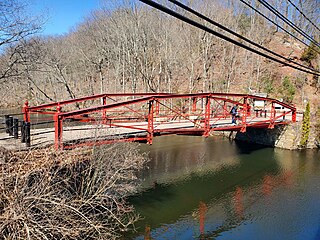
The Red Bridge is a historic bridge spanning the Quinnipiac River near Oregon Road in Meriden, Connecticut. It was built in 1891 by the Berlin Iron Bridge Company, and is one of a small number of surviving lenticular truss bridges in the state, and was listed on the National Register of Historic Places in 1993. The bridge is open to pedestrian traffic only.

The Neshanic Station Lenticular Truss Bridge is a road bridge built over the South Branch Raritan River at Neshanic Station, New Jersey. It was constructed by the Berlin Iron Bridge Co. in 1896. and listed on the National Register of Historic Places as a contributing structure to the Neshanic Station Historic District on February 8, 2016.

The Sheffield Street Bridge is a historic lenticular truss bridge spanning Hancock Brook in Waterbury, Connecticut. Built in 1884, it is a rare example of a wrought iron bridge built by the Berlin Iron Bridge Co., and one of the few surviving lenticular truss bridges left in the state. It was listed on the National Register of Historic Places in 2001.

The Washington Avenue Bridge is a historic lenticular truss bridge carrying Washington Avenue over the Mad River in Waterbury, Connecticut. Built in 1881, it is the oldest known surviving example of a lenticular pony truss bridge built by the Corrugated Metal Company, later known as the Berlin Iron Bridge Company, a prolific bridge maker in New England of the late 19th century. The bridge was listed on the National Register of Historic Places in 2001.
